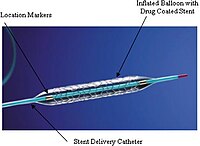
Photo from wikipedia
Background The use of cortical strut allograft has not been determined for Vancouver type B1 or C fracture. This study aimed to evaluate the short-term efficacy of locking compression plating… Click to show full abstract
Background The use of cortical strut allograft has not been determined for Vancouver type B1 or C fracture. This study aimed to evaluate the short-term efficacy of locking compression plating with or without cortical strut allograft in managing these types of fractures. Methods We retrospectively assessed 32 patients (17 males, 15 females; 23–88 years, mean: 67.2 years) with Vancouver type B1 or C fractures. Seventeen patients (Group A; B1 fractures in 15 hips, C fractures in 2 hips) were treated with open reduction and internal fixation with locking compression plates (group A). The other 15 patients (Group B; B1 in 14 hips, C in 1 hip) were fixed by locking compression plating combined with cortical strut allografting (group B). The fracture healing rate, healing time, complications and function were compared between these two groups. Results The mean follow-up time was 32.4 months (12 to 66), and the overall fracture union rate of the 32 patients was 96.9%. Group B had a higher fracture union rate than Group A, but the difference was not statistically significant. Group A had one case of nonunion of type B1 fracture and one case of malunion; the mean time to fracture healing was 5.3 months (3 to 9). In group B, all patients reached bony union without malunion, with a mean time of fracture healing of 5.1 months (3 to 8). Conclusion Treatment of Vancouver type B1 or C fractures by locking compression plating, with or without cortical strut allografting, resulted in similar union rates in these patients. This suggest that, the use of cortical strut allografting should be decided cautiously.
Journal Title: BMC Musculoskeletal Disorders
Year Published: 2022
Link to full text (if available)
Share on Social Media: Sign Up to like & get
recommendations!